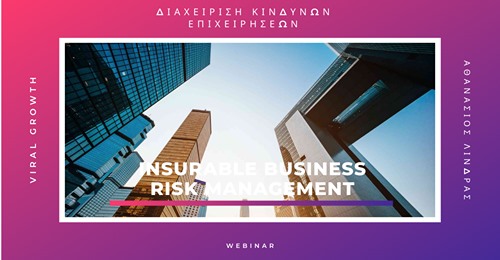
What is BRMA Enterprise Risk Management and what is its value today?
What is BRMA Enterprise Risk Management and what is its value today?
Sustainability of a business means a proper work plan that includes a risk management plan.
In today’s complex business environment the entrepreneur is required to have 100% of his attention on how his business will survive.
New legislation, regulations, both domestic and European, and ever-emerging risks are rapidly changing the risk environment. As a result, the monitoring of critical changes in risks become a major “headache” for the modern entrepreneur.
It has been observed that in conditions of a reduced budget now, where there is no liquidity, the weakness is “chosen” to deal with all the risks that threaten the viability and strategic goals of the business.
Risks that have now been recorded and proven, companies are not aware of in their entire range, resulting in a general inability to prepare a plan to deal with them.
Read: Insurable Enterprise Risk Management Software – BRMA
Historically
BRMA Business Risk Management
The word risk comes from the Latin root “risicare” which means “to dare”, implying that risk is a choice rather than a destiny. The actions we dare to take, which depend on our freedom of choice, essentially characterize the “history” of risk management, but also social evolution. Risk management is embedded in a vast range of decision-making from portfolio asset allocation to ensuring public health, from deep-sea oil extraction to environmental protection, from paying insurance premiums to using seat belts in cars. In any case, risk means exposure to uncertainty and concerns, on the one hand, human activities – it is a daily way of life and thinking – and on the other hand, all businesses. Michael Charalambidis.
Business Risk Management VS Insurable Business Risk Management
Insurance pays for damages when the risk occurs. Risk management provides a clear and structured approach to identifying risks.
Business Risk Management
Risk management is the process of identifying, assessing and controlling threats to an organization’s capital and profits. These risks arise from a variety of sources, including financial uncertainties, legal liabilities, technological issues, strategic management errors, accidents and natural disasters.
Insurable Risk Management
A financial risk management tool in which the insured transfers a risk of potential financial loss to the mitigating insurance company in exchange for a monetary contribution known as a premium.
Insurable risks are risks that insurance companies will cover. These include a wide range of losses, including those from fire, theft or lawsuits. When you buy commercial insurance, you pay premiums to your insurance company. In return, the company agrees to indemnify you in the event you suffer a covered loss.
Enterprise Risk Management Architecture
BRMA Business Risk Management
As a process that concerns every activity of a company, integrated risk management needs an effective architecture. A complete enterprise risk management architecture includes the following six benefits:
- Integrated and modern organizational structures for business risk management
- Standardized risk management procedures
- Comprehensive risk management manuals
- Effective risk warning system
- Effective prevention system and
- High performance risk management information system
Enterprise risk architecture helps companies stay competitive and minimize their losses at critical times. These are the times when poorly managed companies struggle to survive. On the other hand, companies that have risk management processes in place tend to minimize their losses.

5 Benefits of a Business Risk Management Program
- It helps to see dangers that are not obvious.
- Provides information and support to the Board of Directors.
- Creating a more effective “defense” in group actions.
- Reduction of business liability.
- Framing regulatory issues.
Architectural Business Risk Management Process
BRMA Business Risk Management
Enterprise risk management architecture processes are part and parcel of overall business operations. These processes are used to manage and monitor ever-changing risk environments.
The process of business risk architecture is the structural design of actions, including input, processing and output elements. This architecture captures and describes risk management processes, the components and interactions of each activity, and how business risk management processes work together with other enterprise activities.
While risk management processes can be very detailed and vary by organization and industry, there are five that all organizations should have in place:
Risk identification.
This is the collection of procedures aimed at automating a standard, objective approach to identifying risk. Understand your environment.. It is about the internal business context, the external environment in which the business operates and your strategy for where the business is headed. On an ongoing basis, and separate from the monitoring of individual risks, is the continuous process of monitoring the risk, regulatory and business environment as well as the internal business environment. The purpose is to identify opportunities as well as risks that evolve and affect the organization’s overall goals and performance. A variety of regulatory, environmental, economic, geopolitical and internal business factors can affect the success or failure of any organization. This includes natural disasters, disruptions, commodity availability and pricing, industry developments and geopolitical risks. It also includes monitoring relevant legal and regulatory environments in the respective jurisdictions to identify changes that could affect the business and its objectives.
Risk assessment.
Once an organization identifies the risk, they can then identify what can help or hinder your goals. An organization wants to determine the probabilities of outcomes for what might affect the achievement of its objectives. This should go beyond heat maps to include a variety of analysis and risk assessment techniques. Ask us.
Risk treatment.
Once the range of available solutions is understood, the organization must decide what to do. What will be the best route to achieve his goals, minimizing loss/damage. This falls under risk measurement activities to understand inherent and residual risk while considering risk strategies of risk acceptance, risk transfer (insurance), risk avoidance or risk mitigation (controls). The goal is to optimize value and return while keeping risk at acceptable levels of risk tolerance.
Risk monitoring.
This stage includes a series of procedures for the continuous monitoring of risks in the organization. These activities are those that are typically done within the organization to monitor and assess risks on an ongoing basis.
Communications and risk declarations.
Continuous processes to manage communications and interactions with risk owners throughout the risk management lifecycle. These are done on a periodic basis or when certain risk conditions are triggered.

Effective business risk management actions offer:
Holistic risk awareness.
This means that there is a defined enterprise-wide risk taxonomy that structures and categorizes risks within the enterprise and assigns accountability. A consistent process identifies risk and keeps the classification up to date. Various risk frameworks are harmonized into a business risk framework. The existing IT architecture aggregates risk data and effectively communicates, monitors and manages risk.
Establish a risk culture and policy.
Establish a risk culture and policy The risk policy must be communicated across the enterprise to create a culture of risk management. Risk policies are kept up to date, reviewed and audited on a regular basis. Risk appetite and tolerance are determined and reviewed within the business context and continuously aligned with business performance and goals. The technology monitors key risk indicators (KRIs) to ensure risk policy management and risk management against risk appetite, tolerance and capability.
Smart risk decision making.
This means the business has everything it needs to make smart business decisions. Risk strategy is integrated with business strategy. It is an integral part of business responsibilities. Risk assessment is done in the context of business change and strategic planning and is structured to complement the business life cycle to help executives make effective decisions.
Risk responsibility.
Accountability and ownership of risk are established features of risk management. Each enterprise and business process level risk has clearly established owners. Risk is communicated to stakeholders and the organization’s track record should demonstrate successful management of risk against established risk tolerances and appetite.
Multidimensional risk analysis and planning.
The organization needs a range of risk, correlation and scenario analysis. Various qualitative and quantitative risk analysis techniques must be in place, and the organization needs to understand historical loss to feed the analysis. Risk treatment plans – whether acceptance, avoidance, mitigation or transfer – must be effective and monitored for progress.
Risk visibility as it relates to performance and strategy.
The business views and categorizes risk in the context of corporate optimization, performance and strategy. KRIs are implemented and mapped to key performance indicators (KPIs). Risk indicators are assigned established thresholds and trigger business-related reporting that is effectively communicated. Risk information adheres to the quality, integrity, relevance and timeliness of information.
# Case studies – Case studies
BRMA Business Risk Management
https://link.springer.com/content/pdf/10.1111/1468-0440.00233.pdf
https://www.emerald.com/insight/content/doi/10.1108/03055721211207761/full/html
https://www.jstor.org/stable/251500
https://www.researchgate.net/publication/2637282_KDD_For_Insurance_Risk_Assessment_A_Case_Study
https://www.researchgate.net/publication/350323681_Risk_Management_and_Insurance_-_Case_solution
What exactly is BRMA Enterprise Risk Management and what is it for?
The object of Business Risk Architecture is their in-depth identification and the design of the most appropriate methods of prevention, treatment and suppression.
This architecture synthesizes individual knowledge from finance, private insurance and investments.
At the same time, it overlaps with related but distinct scientific branches such as marketing, strategic communication, sales negotiation, corporate reputation management.
As with architecture by definition, here too its unequivocal definition is considered problematic, as accredited Business Risk Management Architects and Business Managers do not converge exclusively into one.
But surely the new businesses of today will be the legacy of tomorrow and every effort must be made to ensure that today’s business activity is of high quality”
And the latter must give a new definition of business heritage and the goals of comprehensive preservation and bequest for future generations.

